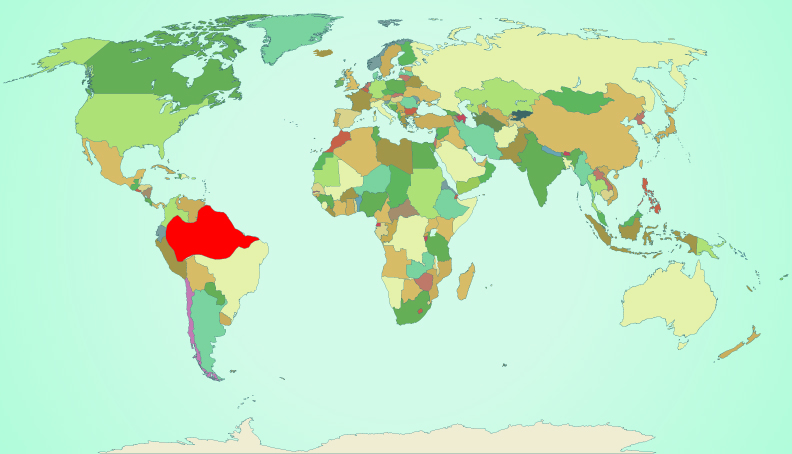Two Toed Sloth
Choloepus didactylus
Range: The Two toed sloth is found through Venezuela, Colombia, the Guiana’s, Brazil and into the upper Amazon Basin of Ecuador and Peru.
Habitat: The Two toed sloth is found in tropical moist lowland and montane forest.
Threats: Habitat loss is the major threat to the sloth. Two-toed sloths are well camouflaged in tree canopies. Their most common resting position is curled into a ball in the branches which resembles either a termite nest or a knot in the wood. This, combined with the green colour of their fur, makes for great protection from predators. They are not as commonly hunted as armadillos or tamanduas. They are, however, increasingly caught for sale as pets to tourists in Colombia.
Social Behaviour: The two-toed sloth is nocturnal, sleeping during the daytime and eating at night, they move very slowly one limb at a time, at about 0.5 km per hour, but are capable of speeds up to 1.6 km per hour.
Information: Sloths spend most of their life hanging upside-down from tree branches, whether sleeping, eating, mating, or giving birth. They descend to the ground only to change trees (food source) or to defecate (pooh) and because of their low metabolic rate they defecate only once each week! Food remains in their relatively short digestive tract for approximately one month. Sloths have been known to defend themselves with their claws and teeth, but they are usually quite docile, relying primarily on camouflage to protect them. Although normally brown, often the fur has a greenish tinge caused by microscopic plants that live on the hairs. The under fur is dense, often matted, while the outer fur is finer and sleek.
The hair flows back from the head and as the animal is almost constantly upside down, the body hair lies from belly to back so that the rain will run off. A sloth’s temperature can vary by more than 10 degrees F, changing according to the surrounding temperature.
Sloths are actually much better at swimming than walking, using their strong fore feet to propel themselves through the water, although they spend almost all of their time in the trees. Swimming is an adaptation to the annual floods that occur in the forest. There are two claws on each fore foot and three on the hind feet. The fore claws measure up to 7.5 cm.
The hair flows back from the head and as the animal is almost constantly upside down, the body hair lies from belly to back so that the rain will run off. A sloth’s temperature can vary by more than 10 degrees F, changing according to the surrounding temperature.
Sloths are actually much better at swimming than walking, using their strong fore feet to propel themselves through the water, although they spend almost all of their time in the trees. Swimming is an adaptation to the annual floods that occur in the forest. There are two claws on each fore foot and three on the hind feet. The fore claws measure up to 7.5 cm.
Modern sloths are divided into two families based on the number of toes on their front feet. Two-toed sloths are larger than their three-toed cousins. They also have longer hair, bigger eyes, and their back and front legs are more equal in length. Two-toed As the name implies, they have only two toes on their forefeet, although, like other sloths, they have three toes on the hind feet. They are also larger than three-toed sloths, with a body length of 58-70 cms, and weighing 4-8 kg. Other distinguishing features include a more prominent snout, longer fur, and no tail.Modern sloths are divided into two families based on the number of toes on their front feet. Two-toed sloths are larger than their three-toed cousins. They also have longer hair, bigger eyes, and their back and front legs are more equal in length. Two-toed As the name implies, they have only two toes on their forefeet, although, like other sloths, they have three toes on the hind feet. They are also larger than three-toed sloths, with a body length of 58-70 cms, and weighing 4-8 kg. Other distinguishing features include a more prominent snout, longer fur, and no tail.
Breeding: After a gestation period of 7-10 months., a single young is born and is carried on the mother’s body for 6-9 months, hooking itself securely into her fur. By about 1 month it begins to take leaves chewed by the mother and after a further month it can pick its own leaves from those it can reach. It reaches adult size between 2-3 years old.
Projects: ESB
Map: Red = Locations Found 835




